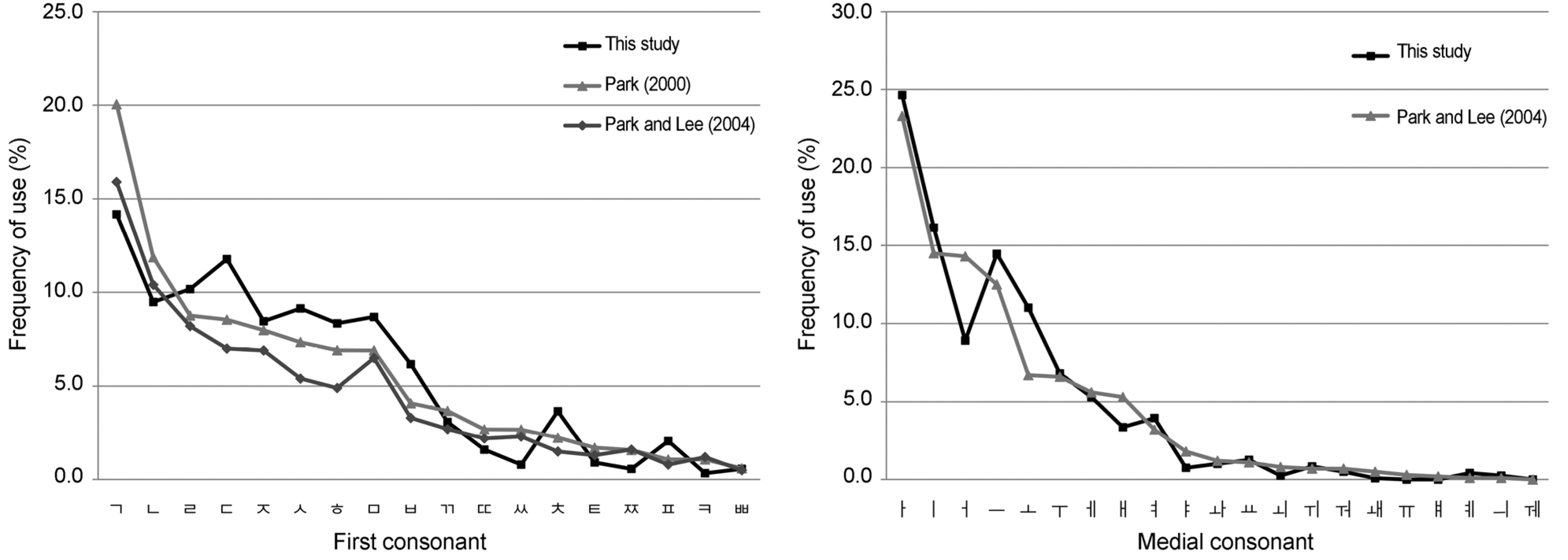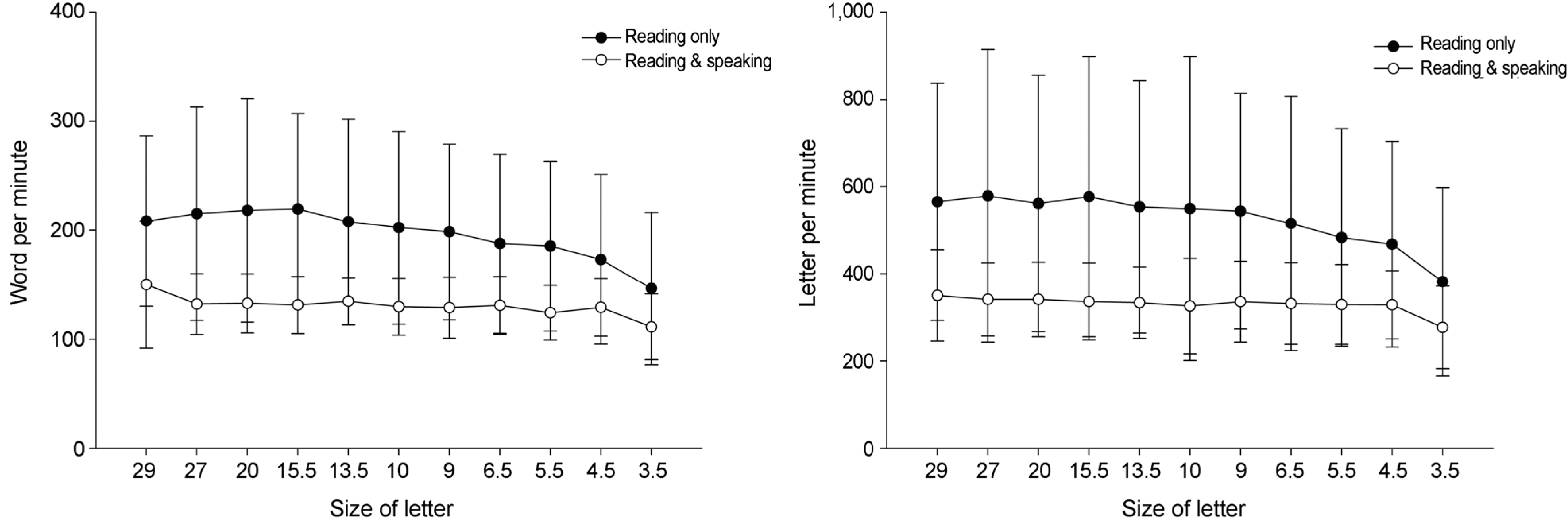J Korean Ophthalmol Soc.
2016 Apr;57(4):642-649. 10.3341/jkos.2016.57.4.642.
Validity of Korean Version Reading Speed Application and Measurement of Reading Speed: Pilot Study
- Affiliations
-
- 1Department of Ophthalmology, Chungbuk National University College of Medicine, Cheongju, Korea. smh@chungbuk.ac.kr
- KMID: 2212800
- DOI: http://doi.org/10.3341/jkos.2016.57.4.642
Abstract
- PURPOSE
Reading speed is one of the methods used to measure near visual function. Although several versions of reading charts in different languages have been introduced, there is no Korean version of the reading chart yet. Therefore, we investigated the reading speed of normal-sighted Korean people using a recently developed reading speed application for the iPad tablet in Korea.
METHODS
Normal-sighted participants without presbyopia were included and a third generation retina display iPad was used to measure reading speed. The iPad screen was set to maximum brightness and the examination was performed at a distance of 40 cm. Reading speeds were recorded twice: one for reading the sentence silently (reading only) and one for reading the sentence out loud (reading & speaking).
RESULTS
The test sentences used in the application had 18.9 ± 2.6 letters and 6.5 ± 0.7 words on average. Twenty-five males and seventeen females were included. The average of the reading only speed was 202.3 ± 88.4 words per minute (WPM), and that of the reading & speaking speed was 129.7 ± 25.9 WPM, showing a statistically significant difference (p < 0.001).
CONCLUSIONS
This Korean reading chart application is the first self-reporting reading chart in Korean. This chart could present a new standard for measuring both reading only and reading & speaking speeds.
Keyword
Figure
Cited by 1 articles
-
Comparison of Reading Speed after Bilateral Bifocal and Trifocal Intraocular Lens Implantation
Moses Kim, Jae-hyung Kim, Tae-Hyung Lim, Beom Jin Cho
Korean J Ophthalmol. 2018;32(2):77-82. doi: 10.3341/kjo.2017.0057.
Reference
-
References
1. Chia E, Wang JJ, Rochtchina E, et al. Impact of bilateral visual impairment on health-related quality of life: the Blue Mountains Eye Study. Invest Ophthalmol Vis Sci. 2004; 45:71–6.
Article2. Legge GE, Ross JA, Isenberg LM, LaMay JM. Psychophysics of reading. Clinical predictors of low-vision reading speed. Invest Ophthalmol Vis Sci. 1992; 33:677–87.3. Legge GE, Ross JA, Luebker A, LaMay JM. Psychophysics of reading. VIII. The Minnesota Low-Vision Reading Test. Optom Vis Sci. 1989; 66:843–53.4. Radner W, Obermayer W, Richter Mueksch S, et al. The validity and reliability of short German sentences for measuring reading speed. Graefes Arch Clin Exp Ophthalmol. 2002; 240:461–7.
Article5. Mataftsi A, Bourtoulamaiou A, Haidich AB, et al. Development and validation of the Greek version of the MNREAD acuity chart. Clin Exp Optom. 2013; 96:25–31.
Article6. Kniestedt C, Stamper RL. Visual acuity and its measurement. Ophthalmol Clin North Am. 2003; 16:155–70. v.
Article7. Kim JH, Lee JW, Chung JL, et al. Combined implantation of monofocal and multifocal intraocular lenses in senile cataract surgery. J Korean Ophthalmol Soc. 2009; 50:1632–8.
Article8. Lee KB, Lee HJ, Jun SW, et al. A Study of Correlation among Visual-verbal Skills, Binocular Vision and School Achievement. Korean J Vis Sci. 2008; 10:197–216.9. Lee SJ, Park JH, Whang KH, Rye GC. The Study on Improvement of Reading Ability for Dyslexia Wearing Color filter lens (ChromaGenTM Lens). J Korean Oph Opt Soc. 2011; 16:65–74.10. Park SH, Kim SH, Cho YA, Joo CK. The effect of colored filters in patients with Meares-Irlen syndrome. J Korean Ophthalmol Soc. 2012; 53:452–9.
Article11. Park DG, Lee SJ. A quantitative study on specific syllables used in the colloquial speeches of students. Korean Language Research. 2004; 14:181–99.12. Park SL. A study on the frequencies of consonants in adult conversational Korean. [Masters's thesis]. Ewha Womans University. 2000; 1–68.13. Sloan LL, Brown DJ. Reading cards for selection of optical aids for the partially sighted. Am J Ophthalmol. 1963; 55:1187–99.14. Rubin GS. Visual acuity and contrast sensitivity. Ryan SJ, editor. Retina. 5th ed.St Louis: Mosby;2013. 1:chap. 11.
Article15. Ishii M, Seki M, Harigai R, et al. Reading performance in patients with glaucoma evaluated using the MNREAD charts. Jpn J Ophthalmol. 2013; 57:471–4.
Article16. Ergun E, Maár N, Radner W, et al. Scotoma size and reading speed in patients with subfoveal occult choroidal neovascularization in age-related macular degeneration. Ophthalmology. 2003; 110:65–9.
Article
- Full Text Links
- Actions
-
Cited
- CITED
-
- Close
- Share
- Similar articles
-
- A Comparison of Reading Speeds of Intermittent Exotropia and Normal Children
- Korean Version Self-testing Application for Reading Speed
- Comparison of Near-Distance Reading Speed Based on the Intraocular Lens Type Using a Korean Reading Speed Measurement Application
- The Usefulness of Aspheric Doublet Lens
- Reading Speed after Anti-vascular Endothelial Growth Factor Therapy in Patients with Wet Age-related Macular Degeneration



